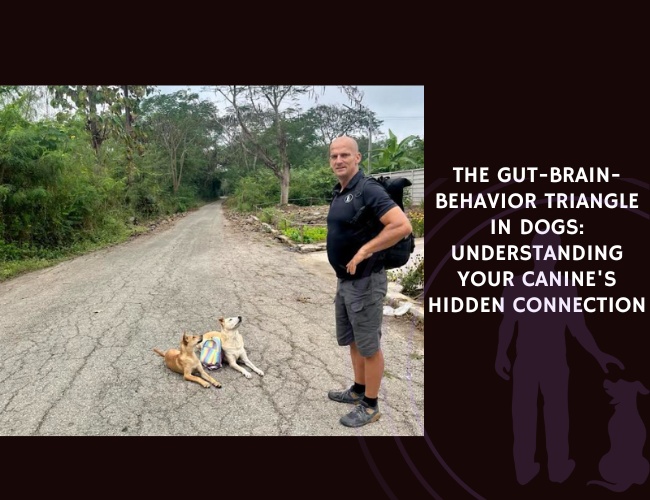Introduction
Your dog’s ability to anticipate your every move isn’t just adorable—it’s a sophisticated neurological process that shapes their entire world. From the moment they hear your car keys jingle to their uncanny ability to know when it’s dinnertime (even without checking the clock), dogs demonstrate remarkable predictive capabilities that rival some of the most complex cognitive processes we see in the animal kingdom.
This predictive brain mechanism, rooted in evolutionary survival strategies, allows our canine companions to navigate their environment with remarkable efficiency. By constantly generating predictions about what will happen next and comparing these expectations with reality, dogs create an internal model of their world that influences everything from their daily routines to their deepest anxieties. Let us guide you through the fascinating science behind how your furry friend’s brain anticipates, adapts, and sometimes struggles with the unpredictable nature of life alongside humans.
Understanding the Predictive Brain Model in Dogs
The Science Behind Canine Prediction
Your dog’s brain operates as a sophisticated prediction machine, constantly generating expectations about the world around them. This remarkable system, known as predictive coding, works by minimizing prediction errors—those moments when reality doesn’t match what the brain expected. When you reach for the leash at an unusual time, you might notice your dog’s momentary confusion before excitement takes over. That brief pause? That’s their predictive brain recalibrating.
The neurological foundation of this system involves complex brain networks similar to those found in humans. The hippocampal-prefrontal-striatal circuits work together to process information, update predictions, and guide behavior. While we can’t peek directly into a dog’s thoughts, research shows these brain regions light up during anticipation tasks, suggesting our four-legged friends possess remarkably sophisticated internal models of their environment.
Evolutionary advantages have shaped this predictive capability over thousands of years. Dogs that could accurately anticipate predator movements, locate food sources, or predict pack behavior had better survival rates. Today, this same mechanism helps your dog anticipate your mood changes, predict daily routines, and even sense when you’re about to come home—sometimes with uncanny accuracy that leaves us wondering if they possess a sixth sense. 🧠
How Predictions Shape Reality
The predictive brain doesn’t just passively wait for things to happen—it actively constructs your dog’s perception of reality. This means that what your dog experiences isn’t just raw sensory data, but a blend of expectation and observation that creates their unique worldview.
Hierarchical processing allows dogs to build predictions at multiple levels, from simple sensory expectations (“that sound means food”) to complex social predictions (“when mom puts on those specific shoes, we’re going to the park”). This layered approach to prediction helps dogs navigate increasingly complex human environments with remarkable adaptability. You might notice how your dog responds differently to you putting on work shoes versus hiking boots—each triggers a different set of predictions and associated behaviors.
The prediction-error learning cycle drives behavioral adaptation. When predictions prove accurate, neural pathways strengthen, making future predictions more efficient. But when reality violates expectations—perhaps you take a different route on your walk—your dog’s brain must update its model. This constant refinement process explains why dogs can adapt to new routines relatively quickly while still maintaining strong preferences for familiar patterns.
How Anticipation Shapes Daily Canine Behavior
Reading the Signs: Anticipatory Cues in Your Dog’s World
Your dog lives in a world rich with predictive cues that you might not even notice. That subtle shift in your breathing pattern when you wake up, the specific way you close your laptop at the end of the workday, or even the particular commercial jingle that plays before their favorite show—all these become powerful anticipatory signals in your dog’s predictive framework.
Feeding anticipation showcases this beautifully. Dogs don’t just respond to the sight of their food bowl; they build complex predictive chains. The time of day, your movement patterns, even the sound of you washing your hands after work can all become part of an elaborate anticipatory sequence. This explains why many dogs start their “dinner dance” well before you’ve even thought about meal prep. Their predictive brain has already connected the dots.
Social interaction predictions reveal the depth of canine emotional intelligence. Your dog learns to anticipate not just your actions but your emotional states. They might bring you their favorite toy when they predict you’re sad, or give you space when they sense tension. This predictive emotional attunement strengthens the human-canine bond and demonstrates how sophisticated their social predictions can become. Did you know that dogs can even learn to predict seizures or blood sugar changes in their humans? This remarkable ability stems from their predictive brain’s capacity to detect subtle physiological changes that precede these events.
Play and exercise anticipation creates some of the most joyful moments in dog ownership. Watch how your dog’s entire demeanor changes when they predict playtime—the play bow, the sparkle in their eyes, the barely contained wiggles. These behaviors aren’t just excitement; they’re physical manifestations of positive predictions flooding their neural pathways with anticipatory dopamine. 🐾
The Emotional Spectrum of Anticipation
Not all anticipation is created equal in your dog’s predictive brain. The emotional valence of predictions—whether positive or negative—profoundly impacts both behavior and wellbeing.
Positive anticipation and reward pathways create a cascade of neurochemical responses that enhance learning and strengthen bonds. When your dog anticipates something pleasant, dopamine floods the nucleus accumbens, creating not just happiness but enhanced attention and learning capacity. This is why training with positive reinforcement is so effective—you’re literally rewiring their predictive brain to associate certain behaviors with positive outcomes. The tail wag that starts before you’ve even picked up the leash? That’s positive anticipation in action, and it’s reinforcing the very behaviors you want to encourage.
Negative anticipation and stress responses work through different neural pathways but with equal power. When dogs anticipate negative events—the car ride to the vet, thunderstorms, or separation from you—their amygdala becomes hyperactive, triggering stress responses before the event even occurs. This anticipatory anxiety can be more distressing than the event itself. You might notice your dog hiding when you bring out the suitcase, even though your trip is days away. Their predictive brain has already fast-forwarded to the separation.
The anticipation balance in daily life determines much of your dog’s emotional wellbeing. A life filled with positive predictions creates a confident, relaxed dog who approaches new situations with curiosity rather than fear. Conversely, a dog whose predictive brain is dominated by negative anticipation may develop chronic anxiety, always waiting for the other shoe to drop. Creating a environment rich in positive predictive cues while minimizing negative anticipatory triggers is key to emotional balance.
The Link Between Predictive Errors and Stress
When Expectations Shatter: Understanding Prediction Errors
Every time reality doesn’t match your dog’s prediction, their brain experiences what scientists call a “prediction error.” These moments of mismatch aren’t just minor inconveniences—they’re powerful learning opportunities that can either strengthen resilience or trigger stress responses.
The cortisol cascade begins almost immediately when significant prediction errors occur. Your dog’s hypothalamic-pituitary-adrenal (HPA) axis springs into action, flooding their system with stress hormones. This response makes evolutionary sense—unpredictability in nature often meant danger. But in our modern world, even benign changes like furniture rearrangement or schedule shifts can trigger this ancient stress response. The intensity of the stress response often correlates with the magnitude of the prediction error and the emotional significance of the violated expectation.
Behavioral manifestations of prediction errors vary widely depending on your dog’s temperament and past experiences. Some dogs respond with increased vigilance, constantly scanning for the next unexpected change. Others might display frustration behaviors like whining, barking, or even redirected aggression. You might notice your typically well-behaved dog suddenly chewing furniture after a major routine disruption—this isn’t spite, but rather a coping mechanism for prediction error-induced stress.
Recovery and adaptation from prediction errors depends largely on your dog’s resilience and the support they receive. Dogs with strong, secure attachments and diverse positive experiences tend to bounce back more quickly from prediction errors. They’ve learned that while predictions sometimes fail, the world generally remains safe and predictable. This resilience is built through experience and can be strengthened through thoughtful training and exposure.
Environmental Unpredictability and Chronic Stress
The modern domestic environment, while safer than the wild, presents unique challenges to your dog’s predictive brain. The unpredictability of human schedules, urban stimuli, and social interactions can create a chronic state of prediction uncertainty.
Shelter and kennel stress provides a stark example of how environmental unpredictability impacts wellbeing. Dogs in shelters face constant prediction errors—different handlers, varying routines, unpredictable social interactions. Their predictive brain, unable to form stable models, remains in a state of hypervigilance. This explains why shelter dogs often display stress behaviors that disappear once they settle into predictable homes. The transformation you see in a rescued dog after a few weeks isn’t just them “learning to trust”—it’s their predictive brain finally able to form stable, reliable predictions about their world.
Urban environment challenges create a unique set of predictive difficulties. The cacophony of city life—sirens, construction, crowds—presents constant novel stimuli that challenge prediction formation. Dogs living in cities often show higher baseline stress levels, not because cities are inherently bad, but because the sheer unpredictability taxes their predictive systems. Successful city dogs are those who’ve learned to create “prediction windows”—understanding that certain types of unpredictability are normal and non-threatening.
Multi-pet household dynamics add another layer of predictive complexity. Your dog must not only predict human behavior but also anticipate the actions of other animals. This social prediction requirement can be enriching when stable hierarchies and routines exist, but stressful when relationships are uncertain or competitive. 😟

How Training Methods Engage the Predictive Brain
Classical Conditioning: Building Predictive Associations
Classical conditioning isn’t just about creating responses—it’s about installing new predictive programs in your dog’s brain. Every time you pair a neutral stimulus with an outcome, you’re essentially teaching their predictive brain a new equation: “When X happens, Y follows.”
The power of predictive cues in training extends far beyond simple commands. When you consistently use a specific tone for “sit” and another for “stay,” you’re creating distinct predictive pathways. Your dog’s brain begins preparing the motor response before you’ve even finished the command. This predictive preparation explains why dogs sometimes perform behaviors before being asked—their brain has detected subtle pre-cues you weren’t even aware you were giving.
Timing and prediction strength matter enormously in classical conditioning. The closer in time the cue and outcome, the stronger the predictive association. This is why immediate marking (with a clicker or verbal marker) is so powerful—it creates a tight predictive link between behavior and reward. Delayed reinforcement weakens these predictive pathways, making learning less efficient. Your dog’s predictive brain works in milliseconds, constantly updating its models based on temporal relationships.
Context-dependent predictions add complexity to training. Your dog might perfectly predict that “sit” in the kitchen means a treat, but the same command at the park might not trigger the same predictive pathway. This isn’t stubbornness—it’s their predictive brain operating with context-specific models. Successful training acknowledges this and systematically builds predictions across various contexts.
Operant Conditioning: Shaping Expectations Through Consequences
While classical conditioning creates predictive associations, operant conditioning shapes behavior through predicted consequences. Your dog’s brain constantly calculates: “If I do X, what will happen?”
Reinforcement schedules as predictive patterns profoundly influence behavior persistence. Continuous reinforcement (reward every time) creates strong but fragile predictions—if the reward stops, the behavior quickly extinguishes. But intermittent reinforcement creates a different predictive model: “Sometimes this works, so it’s worth trying.” This uncertainty paradoxically strengthens behavior because the predictive brain remains engaged, always calculating whether this might be the rewarded trial.
The gambling effect in dogs mirrors what we see in humans. Variable ratio reinforcement (like slot machines use) creates the most persistent behaviors because the predictive brain never quite knows when the payoff will come. This explains why behaviors learned through inconsistent reinforcement—like begging at the table that occasionally works—are so hard to extinguish. The predictive brain maintains hope that the next attempt might succeed.
Punishment and negative prediction create problematic predictive models. When punishment is used, the dog’s brain must predict not just what to do, but what to avoid. This double cognitive load can create anxiety and confusion, especially when punishment is inconsistent. The predictive brain struggles to form clear models when the same behavior sometimes leads to praise and sometimes to scolding. This predictive uncertainty is a major source of behavioral problems and anxiety disorders in dogs.
Building Resilience Through Controlled Unpredictability
The paradox of training is that while dogs thrive on predictability, they also need to cope with unpredictability. The solution lies in controlled, graduated exposure to prediction errors within a safe framework.
Systematic desensitization and predictive recalibration work by gradually adjusting predictive models. When helping a dog overcome fear of thunderstorms, you’re not just reducing fear—you’re rewriting predictive algorithms. Starting with barely audible storm sounds and pairing them with positive experiences, you teach the predictive brain that storm sounds don’t predict danger. This process requires patience because you’re literally rewiring established neural pathways.
Generalization training and flexible predictions prepare dogs for real-world variability. By practicing commands in different locations, with different distractions, and varying rewards, you’re teaching the predictive brain to maintain core predictions while adapting to contextual changes. This flexibility is what separates a well-trained dog from one who only performs in specific situations. The goal isn’t to eliminate prediction but to create adaptive, flexible predictive models.
Errorless learning versus error-based learning represents different approaches to engaging the predictive brain. Errorless learning minimizes prediction errors by setting dogs up for success, building confidence through accurate predictions. Error-based learning allows mistakes, letting dogs learn from prediction errors. Both have their place—errorless learning builds confidence in anxious dogs, while controlled errors build problem-solving skills in confident ones. 🧡
When Predictions Go Wrong: Understanding Behavioral Problems
Anxiety Disorders: The Overpredictive Brain
Anxiety in dogs often stems from a predictive brain that’s become hypervigilant, seeing potential threats where none exist. This overprediction of danger creates a exhausting cycle of constant vigilance and stress.
Generalized anxiety and prediction overflow occurs when the predictive brain can’t contain threat predictions to specific contexts. A dog might start predicting danger everywhere—every sound could be a threat, every stranger potentially dangerous. This predictive overflow exhausts cognitive resources and creates chronic stress. You might notice your anxious dog seems tired despite little physical activity—their brain is exhausting itself maintaining constant threat predictions.
Specific phobias and predictive fixation show how the predictive brain can become locked onto particular threat predictions. A single bad experience with fireworks can create a predictive model so strong that even distant rumbling triggers full panic. The predictive brain doesn’t wait for actual fireworks—it preemptively activates stress responses based on minimal cues. This anticipatory anxiety can be more distressing than the feared event itself.
Social anxiety and complex predictive failures reveal how sophisticated canine social predictions can become dysfunctional. Dogs with social anxiety struggle to predict other dogs’ intentions, defaulting to threat assumptions. Their predictive brain, unable to accurately model social interactions, creates a defensive stance that often provokes the very negative interactions they fear—a self-fulfilling prophecy of failed predictions.
Separation Anxiety: Predicting Abandonment
Separation anxiety represents one of the most distressing predictive disorders in dogs, where the brain catastrophically predicts that separation means permanent loss.
The attachment prediction system in dogs evolved from pack dynamics where separation from the group meant mortal danger. In modern domestic life, this system can become hyperactive, creating predictions of abandonment that don’t match reality. Your dog knows, intellectually, that you’ll return—they’ve seen it hundreds of times. But their emotional predictive system, rooted in ancient survival mechanisms, screams danger anyway.
Predictive cue sensitivity in separation anxiety creates elaborate anticipatory sequences. Dogs learn to predict departure from increasingly subtle cues—the way you check your phone, putting dishes in the dishwasher, even changes in your breathing pattern as you prepare to leave. Each cue triggers escalating distress as their predictive brain fast-forwards to the dreaded separation. This anticipatory anxiety can begin hours before actual departure.
The prediction-panic spiral shows how maladaptive predictions self-reinforce. The dog predicts abandonment, panics, and their panicked state makes accurate prediction even harder. They might destroy doors or windows not from spite but from a desperate attempt to restore predictability by reuniting with you. The destruction then potentially leads to punishment, adding another layer of negative prediction to separation scenarios.
Compulsive Behaviors: When Prediction Fails
Stereotypic and compulsive behaviors often emerge when the predictive brain cannot form coherent models of the environment, defaulting to repetitive patterns that provide artificial predictability.
Repetitive behaviors as predictive anchors serve a self-soothing function. Tail chasing, excessive licking, or pacing create predictable sensory feedback when the external world feels unpredictable. These behaviors aren’t random—they’re desperate attempts by the predictive brain to create some realm of certainty. The repetitive motion provides predictable sensory input that temporarily calms the chaos of failed environmental predictions.
Environmental impoverishment and predictive deficits often underlie compulsive behaviors. Dogs in barren environments or with insufficient stimulation can’t form rich predictive models. Their brain, designed to predict complex environmental patterns, instead locks onto simple, repetitive predictions. This explains why enrichment—providing varied, predictable-yet-interesting experiences—often reduces compulsive behaviors.
The neurochemical trap of compulsions occurs when repetitive behaviors begin triggering their own reward predictions. The brain starts predicting relief from the compulsive behavior itself, creating an addictive cycle. Breaking this cycle requires not just stopping the behavior but providing alternative predictive frameworks that meet the underlying need for certainty and control.
Anticipation. Adaptation. Survival.
Brains built for prediction. Dogs constantly generate expectations about their world, adjusting behaviour when reality shifts—an evolutionary gift that fuels survival and companionship.
Perception blends with expectation. From keys jingling to shoes laced, layered predictions shape how dogs interpret life, linking sounds, sights, and routines to meaningful outcomes.



Learning thrives on errors. Each mismatch between expectation and reality refines neural pathways, helping dogs adapt swiftly while still holding to the comfort of familiar patterns.
Practical Applications for Training and Behavior Management
Designing Predictability Without Rigidity
Creating an environment that supports healthy predictive processing requires balancing structure with flexibility—enough predictability to feel secure, enough variability to build resilience.
Structured routines as predictive scaffolding provide the foundation for emotional security. Consistent meal times, regular walks, and predictable play sessions create a framework of certainty. But within this structure, introduce small variations—take different routes, use different toys, vary the exact timing slightly. This teaches your dog that while the big picture remains stable, small prediction errors are safe and manageable.
Ritual development and predictive comfort can be therapeutic for anxious dogs. Creating specific, predictable sequences for potentially stressful events helps manage predictions. For example, a “vet visit ritual” might include special treats, a favorite toy, and a specific calming routine. These rituals don’t eliminate stress but provide predictable elements within unpredictable situations. Your dog learns to predict that while vet visits happen, certain comforting elements will always be present.
Flexible boundaries and adaptive predictions prepare dogs for real-world unpredictability. Instead of rigid rules, create predictive themes. “We eat around this time,” rather than exactly 6:00 PM. “Good things happen when guests arrive,” rather than specific guest protocols. This thematic predictability provides security while maintaining adaptability. Dogs learn to predict general patterns rather than rigid sequences.
Early Intervention: Recognizing Predictive Problems
Identifying when a dog’s predictive system is struggling allows for early intervention before problems become entrenched.
Behavioral indicators of predictive stress include increased vigilance, difficulty settling, overreaction to minor changes, and inability to recover from surprises. These signs suggest the predictive brain is overwhelmed. You might notice your dog constantly checking doors, unable to fully relax even in familiar environments. This hypervigilance indicates their predictive system is on overdrive, constantly calculating potential threats.
The prediction confidence assessment involves observing how your dog approaches novel situations. Confident predictors show curiosity and quick recovery from surprise. Dogs with predictive difficulties show excessive caution, prolonged stress responses, or complete avoidance. Watch how your dog responds to a new object in familiar space—their reaction reveals much about their predictive confidence.
Predictive flexibility testing helps identify rigid thinking patterns. Can your dog perform known behaviors in new contexts? Do they recover quickly when routines change? Can they adapt when rewards vary? Dogs with flexible predictive systems navigate these challenges smoothly, while those with rigid predictions struggle. This assessment guides training approaches—rigid predictors need gentle, graduated changes; flexible predictors can handle more variety.
Therapeutic Interventions for Predictive Disorders
When predictive problems create behavioral issues, targeted interventions can help recalibrate the predictive brain.
Counter-conditioning and predictive rewriting directly targets maladaptive predictions. By repeatedly pairing feared stimuli with positive outcomes, you gradually rewrite predictive associations. This isn’t just about changing feelings—it’s about fundamentally altering what the brain predicts will happen. Success requires consistency and patience, as you’re competing against potentially years of established predictions.
Predictive confidence building through choice empowers dogs to influence their predictions’ outcomes. Providing choices—which toy to play with, which direction to walk, when to approach or retreat—teaches that they have agency in their predictive world. This sense of control reduces anxiety and builds confidence in their ability to navigate uncertainty. Dogs learn that even when predictions fail, they can adapt and influence outcomes.
Medication and neurochemical predictive support sometimes becomes necessary when the predictive system is severely dysregulated. Anti-anxiety medications don’t just reduce fear—they can help restore the brain’s ability to form accurate predictions by reducing the noise of constant threat detection. Medication provides a window for new, more adaptive predictions to form through training and positive experiences. Think of it as turning down the alarm system’s sensitivity while the predictive brain recalibrates. 🐾
Age-Related Predictive Changes: From Puppyhood to Senior Years 🧠
Puppy Brain Development: Building Predictive Foundations
Your puppy’s predictive brain isn’t just a miniature version of an adult dog’s—it’s a rapidly developing system that undergoes dramatic changes from 8 weeks through adolescence. Understanding these developmental stages helps explain why your puppy seems brilliant one moment and completely clueless the next.
The neurological construction zone in puppies explains much of their chaotic behavior. Between 8-16 weeks, the predictive neural pathways are literally under construction. Your puppy’s brain is forming basic predictive templates: “Human equals safety,” “This sound means food,” “That tone means play.” But these predictions are fragile and easily overwhelmed. This is why puppies struggle with impulse control—their predictive brain can’t yet reliably forecast consequences. When your 10-week-old puppy pees right after you praised them for going outside, they’re not being defiant. Their predictive system simply hasn’t developed enough to maintain behavioral predictions under distraction or excitement.
The adolescent prediction rebellion (roughly 6-18 months) brings its own challenges. Just when you thought your puppy was getting it, adolescence hits and their predictive brain undergoes major reorganization. Previously solid predictions suddenly become unreliable. Your teenage dog might “forget” house training or act like they’ve never heard “sit” before. This isn’t regression—it’s neural pruning and reorganization. The predictive brain is upgrading from simple input-output predictions to complex, contextual processing. During this phase, patience and consistency help stabilize their developing predictive models.
Predictive learning velocity in puppies is both a blessing and a curse. Young dogs form predictive associations incredibly quickly—sometimes from single experiences. This rapid learning means one bad experience can create lasting negative predictions, but it also means positive experiences have powerful protective effects. A puppy who has diverse, positive predictive experiences before 14 weeks develops what researchers call “predictive resilience”—the ability to bounce back from prediction errors throughout life.

Senior Dog Cognitive Changes: When Predictions Fade
As your dog ages, their once-sharp predictive brain begins to show wear, affecting everything from daily routines to emotional regulation. Recognizing these changes early allows for supportive interventions that maintain quality of life.
Cognitive dysfunction and predictive degradation often begins subtly. Your senior dog might stand at the wrong side of the door, forgetting their prediction about which way it opens. They might seek dinner immediately after eating, their meal-time predictions no longer holding. These aren’t just “senior moments”—they represent the breakdown of established predictive models. The hippocampus, crucial for prediction formation and retrieval, shows age-related changes that affect how well predictions stick and how accurately they’re retrieved.
Sundowning and temporal prediction loss affects many senior dogs, particularly those with cognitive dysfunction. As evening approaches, their predictive system becomes increasingly unreliable. They might pace anxiously, unable to predict what comes next in their evening routine. This temporal disorientation is especially distressing because time-based predictions (when meals happen, when family members return) are fundamental to a dog’s sense of security. You might notice your senior dog becoming increasingly anxious in the late afternoon, anticipating… something, but unable to form clear predictions about what.
Adaptive strategies for aging predictive systems can significantly improve senior dogs’ wellbeing. Increasing environmental predictability helps compensate for internal predictive difficulties. More frequent, smaller routines replace long complex ones. Visual and physical cues supplement verbal commands when auditory prediction becomes unreliable. Night lights help with spatial predictions in darkness. The goal isn’t to fix the aging predictive system but to provide external scaffolding that supports remaining predictive abilities. 🧡
Critical Periods: Windows of Predictive Opportunity
Certain developmental windows represent crucial opportunities for establishing healthy predictive patterns that last a lifetime. Missing these windows doesn’t doom your dog, but it does mean working harder to build what could have come naturally.
The primary socialization window (3-14 weeks) is when the predictive brain is most plastic regarding social predictions. Puppies exposed to diverse, positive social experiences during this period develop flexible social predictive models. They learn that new dogs and people, while unpredictable in specifics, are generally safe and interesting. Miss this window, and the predictive brain defaults to caution—treating social novelty as potential threat rather than opportunity. This is why undersocialized dogs often struggle with anxiety; their predictive brain lacks the early templates for positive social predictions.
Fear period navigation (8-11 weeks and 6-14 months) represents times when the predictive brain is hypersensitive to negative experiences. A single traumatic event during these periods can create lasting negative predictions that are difficult to overcome. However, these same periods offer opportunities for building strong positive predictions. Careful management during fear periods—avoiding overwhelming experiences while maintaining gentle challenges—helps develop balanced predictive processing. The key is ensuring prediction errors during these periods are minor and quickly resolved with positive outcomes.
The learning consolidation phase (4-6 months) is when early predictive patterns solidify into more permanent neural structures. This is your golden opportunity for establishing core behavioral predictions—house training, basic commands, and fundamental social rules. The predictive patterns formed during this period become the default templates your dog will use throughout life. While these can be modified later, it requires significantly more effort than getting it right during this critical window.
Breed-Specific Predictive Traits
Working Breed Variations: Evolution Shapes Prediction
Different breeds didn’t just develop different physical traits—they evolved distinct predictive processing styles that suited their original functions. Understanding your dog’s breed-specific predictive tendencies helps explain behaviors that might otherwise seem puzzling or problematic.
Herding breeds and movement prediction showcase perhaps the most sophisticated predictive specialization. Border Collies, Australian Shepherds, and other herders possess an almost supernatural ability to predict movement patterns. Their predictive brain doesn’t just track where something is—it calculates where it will be, considering speed, terrain, and likely escape routes. This hyperdeveloped movement prediction explains why your herding dog tries to control children’s movements or becomes fixated on cars. Their predictive brain is literally built to anticipate and influence movement trajectories. In modern life, this can manifest as obsessive ball chasing or shadow stalking—the movement prediction system seeking stimulation.
Hunting breeds and sequential prediction evolved different predictive specializations. Pointers, retrievers, and hounds excel at predictive chains—complex sequences where one prediction leads to another. A retriever’s brain predicts: bird scent → bird location → flush → shot → fall → retrieve → return → praise. This sequential predictive ability makes them excellent at complex training but can also lead to frustration when sequences are interrupted. Your Lab who brings you toys constantly isn’t just playful—their predictive brain is seeking to complete these deeply ingrained sequences.
Guardian breeds and threat assessment prediction developed to excel at discriminating between normal and abnormal patterns. Livestock guardians and protection breeds have predictive systems finely tuned to environmental baselines. They quickly establish what’s “normal” and react strongly to deviations. This sophisticated anomaly detection makes them excellent guards but can lead to overreaction in busy modern environments. Your Great Pyrenees barking at every passing car isn’t being difficult—their predictive brain is signaling every deviation from the established baseline.
Genetic Predispositions: When DNA Influences Prediction
Genetics doesn’t just influence how your dog looks—it profoundly affects how their predictive brain processes information. Some breeds carry genetic tendencies toward certain predictive patterns, influencing everything from trainability to anxiety susceptibility.
Anxiety-prone breeds and predictive hypersensitivity include many small companion breeds, some herding breeds, and certain working lines. Breeds like Cavalier King Charles Spaniels, German Shepherds, and Vizslas often show heightened predictive sensitivity—they form predictions quickly and strongly, but also struggle to update them when wrong. This genetic tendency toward predictive rigidity means these dogs may need extra support in developing flexible thinking. They’re not “nervous breeds”—they’re breeds whose predictive systems are tuned to high sensitivity, which in our chaotic modern world can manifest as anxiety.
Predictively flexible breeds like Labrador Retrievers, Golden Retrievers, and many spaniel breeds show genetic tendencies toward adaptable prediction systems. These dogs form predictions readily but also update them easily when circumstances change. This predictive flexibility contributes to their reputation as easy-going family dogs. However, this same flexibility can make them seem “stubborn” in training—they’re actually just more willing to test whether predictions still hold rather than blindly following established patterns.
Independent thinkers and autonomous prediction characterize breeds developed to work independently from humans. Terriers, sighthounds, and primitive breeds often show predictive processing that prioritizes environmental cues over human communication. An Akita or Basenji isn’t ignoring you—their predictive brain simply weighs environmental predictions more heavily than human-directed ones. This autonomous predictive style requires different training approaches that work with, rather than against, their genetic predictive tendencies.
Matching Predictive Styles: Finding Your Perfect Match
Choosing a dog whose predictive style matches your lifestyle isn’t about finding an “easy” dog—it’s about finding compatible predictive patterns that create harmony rather than friction.
High-predictability households suit dogs with strong pattern recognition and consistent predictive needs. If your life runs on reliable schedules with minimal variation, breeds with rigid predictive tendencies can thrive. German Shepherds, Rough Collies, and Cavaliers flourish when they can form strong, stable predictions. These dogs find comfort in routine and may actually suffer in overly chaotic environments. Your structured lifestyle, which might bore a flexible predictor, provides exactly the predictive stability these dogs need.
Variable-schedule compatibility requires dogs with flexible predictive systems. If your work schedule varies, you travel frequently, or your household is naturally chaotic, you need a dog whose predictive brain handles uncertainty well. Labrador Retrievers, Poodles, and many mixed breeds show predictive resilience that helps them adapt to changing circumstances. These dogs form predictions but hold them lightly, readily adjusting when situations change. They won’t melt down if dinner is two hours late or if weekend plans suddenly change.
Adventure-ready predictive profiles suit active people who want canine companions for varied activities. Breeds with moderate predictive flexibility combined with strong human-directed prediction work best. Australian Shepherds, Portuguese Water Dogs, and Standard Poodles can maintain core behavioral predictions while adapting to novel situations. Their predictive brains balance stability with adaptability, making them excellent partners for hiking, traveling, or sport activities where conditions constantly change but core rules remain constant.
Human-Dog Predictive Synchronization 🐾
Emotional Contagion: When Your Anxiety Becomes Theirs
The predictive connection between you and your dog runs deeper than simple training—your emotional states directly influence how your dog’s brain forms predictions about the world. This emotional contagion isn’t just mimicry; it’s a fundamental rewiring of predictive patterns based on your emotional broadcasting.
The neurological wireless connection between human and dog involves mirror neurons and emotional synchronization systems that evolution crafted over thousands of years. When you feel anxious about an approaching dog, your body releases cortisol and adrenaline. Your dog’s predictive brain doesn’t just notice these changes—it incorporates them into its own predictions. “Mom is tense, therefore danger is likely.” This happens faster than conscious thought. Your dog isn’t choosing to mirror your anxiety; their predictive system is automatically updating based on your emotional data.
Chronic stress transmission creates lasting changes in your dog’s predictive patterns. If you’re consistently anxious, your dog’s baseline predictions shift toward threat detection. They begin anticipating problems even in neutral situations. Research shows that dogs living with anxious owners show elevated baseline cortisol and heightened startle responses. This isn’t surprising when you understand that your dog’s predictive brain uses your emotional state as a primary data source for environmental assessment. Your stress literally reprograms their predictive algorithms toward hypervigilance.
Breaking the anxiety feedback loop requires conscious intervention in your own emotional regulation. When you notice your dog mirroring your stress, pause and deliberately calm your breathing. Your dog’s predictive brain will detect this shift and begin recalibrating. This isn’t about hiding your emotions—dogs are too perceptive for that. Instead, it’s about providing clear predictive signals that despite your initial concern, the situation is manageable. Your calm becomes their predictive anchor.
Mirror Predictive Patterns: Learning Your Human’s Rhythms
Dogs don’t just live with us—they become synchronized with our patterns, developing predictive models that mirror our daily rhythms, habits, and even our unconscious behaviors.
Behavioral synchrony and routine adoption goes beyond simple schedule matching. Your dog’s predictive brain maps your entire behavioral pattern, from the way you stretch in the morning to your pre-bedtime habits. They learn to predict your mood from your posture, your intentions from your movement patterns, and your availability from your activity level. This is why your dog might bring you their leash right when you’re thinking about a walk—they’ve learned to predict your “walk readiness” from subtle cues you don’t even realize you’re giving.
Predictive mimicry in problem-solving reveals how deeply dogs integrate our cognitive patterns. Dogs living with methodical, systematic people often develop careful, sequential approaches to challenges. Those with impulsive, energetic owners tend toward quick, enthusiastic problem-solving attempts. Your dog isn’t just copying your behavior—their predictive brain is adopting your problem-solving algorithms. This explains why anxious owners often have anxious dogs, and why calm, confident people tend to raise calm, confident dogs.
Activity level synchronization shows predictive adaptation at its finest. Your dog’s energy predictions adjust to match your lifestyle. Weekend warriors’ dogs learn to predict low activity weekdays and high activity weekends, adjusting their arousal accordingly. Night shift workers’ dogs shift their active-rest predictions to match unusual schedules. This isn’t just behavioral adaptation—it’s the predictive brain restructuring its temporal expectations to align with yours.
Building Mutual Predictability: The Dance of Interspecies Harmony
Creating true harmony with your dog means establishing bidirectional predictive patterns where both species can accurately anticipate and respond to each other’s needs.
Conscious cue development involves deliberately creating predictive signals that both you and your dog understand. Instead of random interactions, establish clear predictive sequences. “Coffee first, then dog attention” becomes a mutual prediction. Your dog learns to predict when you’re available, and you learn to predict when they’ll seek interaction. This mutual predictability reduces frustration and strengthens your bond. It’s not about rigid rules but about creating shared predictive frameworks.
Emotional availability signaling helps your dog predict when you’re open to interaction versus when you need space. Develop clear signals—maybe sitting in a specific chair means cuddle time, while working at your desk means independent time. Your dog’s predictive brain quickly learns these patterns, reducing attention-seeking behaviors at inappropriate times. Similarly, learn to read your dog’s availability signals. That specific way they curl up might predict they want rest, not play. This bidirectional prediction creates respectful coexistence.
Stress co-regulation strategies build resilient predictive patterns for both species. When facing stressful situations together—vet visits, thunderstorms, or new environments—establish predictive rituals that signal mutual support. Maybe it’s a specific calming touch, a particular phrase, or a breathing pattern you both recognize. These shared predictive anchors help both your nervous systems regulate. Your dog learns to predict that your calm presence means safety, and you learn to predict that supporting your dog helps calm your own anxiety. This creates an upward spiral where each partner’s regulation supports the other’s predictive confidence.
The Future of Predictive Brain Research in Dogs
Emerging Technologies and Insights
The field of canine cognitive neuroscience is rapidly evolving, with new technologies providing unprecedented insights into how dogs predict and perceive their world.
Advanced neuroimaging and real-time prediction mapping now allows researchers to observe predictive processes as they happen. Functional MRI studies reveal which brain regions activate during anticipation, how prediction errors register neurologically, and how individual dogs vary in their predictive processing. These insights are revolutionizing our understanding of canine cognition and emotional processing.
Genetic markers for predictive traits are being identified, suggesting that predictive tendencies have hereditable components. Some breeds show stronger predictive abilities in specific domains—herding dogs excel at movement prediction, while scent hounds show superior olfactory prediction. Understanding these genetic influences helps match dogs with appropriate homes and training approaches.
Wearable technology and predictive monitoring promises to make predictive assessment accessible to all dog owners. Devices that monitor heart rate variability, activity patterns, and stress indicators could alert owners to predictive distress before behavioral problems emerge. Imagine knowing your dog is experiencing prediction anxiety before they show obvious signs—early intervention could prevent countless behavioral issues.
Applications in Working Dog Selection and Training
Understanding predictive processing is transforming how we select and train working dogs for various roles.
Predictive profiling for service dog selection helps identify puppies with optimal predictive traits for assistance work. Dogs who maintain calm predictions in novel situations, show flexible adaptation to prediction errors, and demonstrate strong human-directed predictive attention make ideal candidates. This scientific approach to selection improves success rates and reduces washout in expensive training programs.
Task-specific predictive training tailors methods to the predictive demands of different roles. Detection dogs need precise olfactory predictions, therapy dogs require emotional prediction abilities, and protection dogs must accurately predict threats. Understanding these specific predictive requirements allows for more targeted, efficient training protocols.
Predictive resilience in high-stress roles is now recognized as crucial for working dog welfare. Dogs in military, police, or search-and-rescue roles face constant predictive challenges. Building strong predictive resilience through graduated exposure, positive prediction reinforcement, and regular predictive recalibration helps maintain both performance and wellbeing in these demanding roles.
Conclusion: Living with Your Dog’s Predictive Brain
Understanding your dog’s predictive brain transforms how we interpret their behavior, meet their needs, and strengthen our interspecies bond. That seemingly psychic ability to know when you’re coming home, the anxiety before vet visits, the joy at hearing their leash—all these behaviors stem from a sophisticated neural system constantly predicting and adapting to the world around them.
Living harmoniously with your dog means respecting their predictive nature while helping them build resilience for our unpredictable human world. Create predictable foundations that provide security, introduce controlled variability that builds confidence, and recognize when predictive systems need support. Your dog’s predictive brain is simultaneously robust and fragile, capable of remarkable adaptation yet vulnerable to overwhelming uncertainty.
The journey of understanding your dog’s predictive brain is really about understanding their experience of the world. When you see your dog through this lens—as a creature constantly predicting, adjusting, sometimes succeeding and sometimes struggling with those predictions—compassion and effective support naturally follow. You’re not just training behaviors; you’re helping shape how your dog predicts and experiences their reality.
Moving forward, consider how you can enrich your dog’s predictive world. Can you create more positive anticipation in their day? Might some of their challenging behaviors stem from predictive difficulties you could address? How can you build their confidence in navigating prediction errors? These questions open doorways to deeper understanding and stronger bonds.
Remember, every interaction with your dog engages their predictive brain. The consistency of your love, the reliability of your care, and the predictability of your bond create the ultimate positive prediction: that life with you is safe, enriching, and full of good things to come. In the end, perhaps the most powerful gift we can give our dogs is the confident prediction that tomorrow will be another good day together. 🧡
Is your dog’s predictive brain thriving or struggling? Consider their daily routines, their stress responses, and their ability to handle change. Understanding these predictive mechanisms empowers you to provide not just training, but genuine cognitive and emotional support for your faithful companion. After all, in helping our dogs build healthy predictions, we create a more predictable, secure world for them—and they, in turn, enrich our own lives with their remarkable ability to anticipate our needs, share our joys, and comfort us through life’s unpredictable moments.










